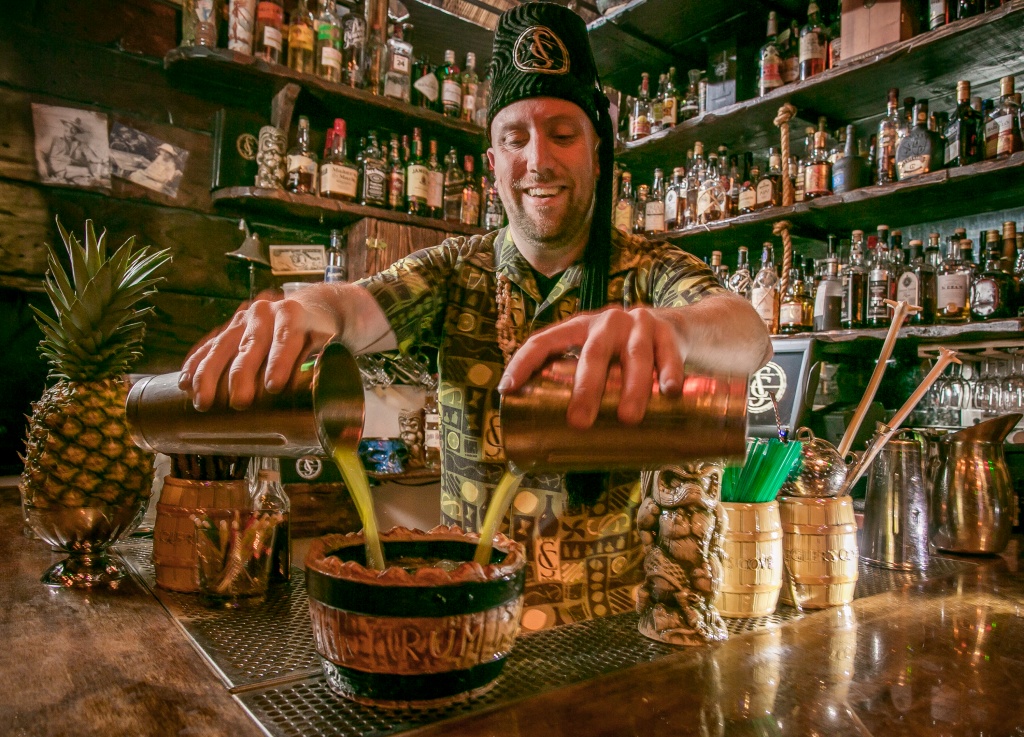How a San Francisco Rum Aficionado Turned His Dreams into a Tiki Empire During an Economic Downturn
4 Min Read By Bob House
Filled with tropical themed drinks and Polynesian-inspired decor, tiki bars bring a slice of island life to the mainland. Tiki bars first rose to watering hole fame in the mid-1930s, offering a brief yet festive escape during the World War II era and quickly attracting the Hollywood elite. More than 70 years after Don’s Beachcomber Cafe first opened, tiki bars continue to be a big hit with patrons across the country.
In 2009, fresh off the tail end of the great recessions, a San Francisco bartender was betting big on the staying power of tiki bars. Martin Cate had experience in the tiki industry as a co-owner of Forbidden Island in the East Bay California town of Alameda. Fueled by a his lifelong passion for rum and vintage tiki bars, Cate decided to sell his Forbidden Island shares to his partners and search for a location to start his very own island-inspired watering hole.
How One Man Pursued a Solo Business Venture Following the Economic Downturn
Cate’s success with Forbidden Island garnered him national media attention and instilled in him the confidence to pursue his own business in the San Francisco area. But finding properties in California with Cate’s desired liquor-only license proved to be a difficult first challenge. While California venues serving both food and alcohol possess a more commonly available liquor license, bars that serve only alcoholic beverages without food need a more rare and expensive liquor license in order to operate
Luckily, Cate quickly found a business-for-sale listing for a three-story bar, formally called Jade, in the heart of San Francisco. As fate would have it, the bar also had a waterfall and pond in the center of the space, something Cate envisioned in his tiki concept.

As a first-time independent owner, Cate struggled to secure a loan following the 2008 recession. Still feeling the sting of the economic downturn, banks were far from eager to hand out loans and were especially wary of lending to a concept bar. In fact, in 2009, the number of annual businesses being bought and sold plummeted 28 percent nationally, according to BizBuySell’s 2009 Annual Insight Report. Even businesses that were able to sell showed declining median revenues, cash flows, asking prices and sales prices, suggesting the small business market was far from over the recession.
In order to secure a loan, Cate had to take a home equity line out of his in-law’s house, while his dad agreed to co-sign the lease. Despite the risk, Cate knew he had found his perfect location and pulled the trigger, closing the deal within a month of finding the Jade on the market. As part of the deal, he negotiated a six-month escrow, giving him time to work on renovations, decor and producing custom inventory.
“The whole sales process was incredibly intimidating,” said Cate. “But I really had a passion and belief in this tiki bar concept. I always tell others to just go forth and be confident that your concept can work. It might be scary, but it can be worth the risk.”
What Opening the Smuggler’s Cove Taught Cate about Serial Entrepreneurship
Since launching in 2009, the Smuggler’s Cove has been awarded the title of “Best American Cocktail Bar” in the 2016 Spirited Awards. It has also been listed on Drinks International’s World’s 50 best bars list for six consecutive years. While his eight years of ownership have brought Cate considerable success, they have also taught the rum enthusiast valuable lessons about opening a bar on his own. Here are four things Cate recommends to first-time owners looking to get into the bar business:
- Build Up Liquidity in Advance: Despite sharing bar ownership prior to the Smuggler’s Cove, Cate had to reestablish his relationships with every liquor distributor and supplier. This is especially challenging for owners working with supplies who require credit checks, as it can take new businesses several weeks to build up a line of credit. Cate stresses the importance of building up liquidity prior to working with partners so you can have cash to hand for day-to-day operations.
- Minimize Interactions with the City: When building renovations involve foundational changes like wiring and plumbing, business owners must prepare to work with city agencies like the health and fire department. Large, structural changes often necessitate local public sector intervention which, in major cities like San Francisco, can add weeks or months to a project. Cate was fortunate enough to only need cosmetic renovations on his property, and suggests looking for properties that require light touch-ups to keep project timelines on track.
- Prioritize Tasks Needed for Opening Day: With a laundry list of things that need to be completed before launch, Cate focused on tasks that were absolute must-haves for opening day. Negotiating the extended six-month escrow helped with this. New owners should make a list to determine what tasks are must-haves for opening and what smaller tasks can wait until you have a revenue stream. This should be done in advance of the business purchase if possible.
- Clearly Define Every Role and Process: In order to minimize mistakes and delays, business owners should explicitly spell out every employee’s role, processes and workflow systems. Tasks like opening and closing procedures need to be clearly defined to ensure consistency and to simplify the onboarding process for new hires. Cate suggests posting procedural documents in a place where employees can see them to avoid confusion and ensure operations run smoothly.
Above all, Cate’s passion for vintage tiki bars and rum is what drove the Smuggler’s Cove towards success. Drawing on his previous bar ownership experience, Cate was able to bring his tropical-themed vision to life while also learning how to be an effective independent entrepreneur.


